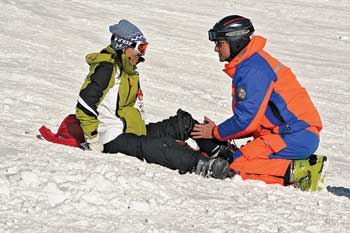Skiing: new equipment, new risks Recommendations for enjoying yourself in safety
The winter sport par excellence, skiing attracts an ever-growing number of followers and practitioners of all ages and backgrounds. For several decades, in fact, you can find on the pistes, beyond ‘traditional’ skiers, many snowboarders and alpine skiers who use the most advanced technology to improve their performance and make their descent more exciting. Dr Andrea Parma, a specialist in back surgery at the USC (Unità Strutturale Complessa – Complex Structural Unit) for Orthopaedics and Traumatology of the United Hospitals of Bergamo, has always been a lover of skiing, and since 1999 has been associated with FISPS-AKJA, Lombardy Section (A voluntary association operating in the field of safety on the pistes), where he carries out some studies and offers some advice on having fun in safety.
Sci carving“Fitted skis, often called carved skis, have now replaced ‘traditional’ skis, which has completely changed the technique of skiing. Traditional skis demanded stretching and flexing to take curves, , whereas ‘carved’ skis, wider at the front and back and narrower in the middle, require a continuous shifting weight from one foot to the other, with a resulting change of the centre of gravity to effect a curve and a change of direction. In this way the skis carry out a curve naturally, and it is as if they turn ‘by themselves’.
Talking of snowboards… Snowboarding is still considered as a new entry: a sport with access limited almost exclusively to the young, and which for the collective imagination has rather taken on the image of a sport for daredevils, because it is often practised by young people, off-piste. Snowboarding is still considered as a new entry: a sport with access limited almost exclusively to the young, and which for the collective imagination has rather taken on the image of a sport for daredevils, because it is often practised by young people, off-piste. The board requires a serious commitment, considerable ability and a good sense of balance, especially in handling the numerous and often damaging falls on the snow, but in themselves snowboards are no more or less dangerous than skis. It is simply that snowboarders and skiers do not suffer the same types of accidents. For example, snowboarders run considerably fewer risks for the lower limbs: the clips are parallel and twisting of the knee is very rare. But fractures in the upper body are much more common, especially in the bones of the forearms (radius and ulna) and the hands because they brace themselves on these when they fall. They may also suffer damage to the neck and the lower part of the back. To minimise any possible damage, it is necessary to make falling less damaging, lifting the board from the snow, a move which, unfortunately, is not really instinctive...”.
Some valuable recommendations for having fun in safety “You can never have enough prudence and good sense: this is a simple idea but one that needs to be taken seriously. Even expert skiers sometimes forget it and, sure of their own abilities, take more risks than people putting on their skis for the first time.
Akja Palamonti via Pizzo della Presolana, 15 - 24125 Bergamo Tel.+39 035.41.75.475 Skype akjasoccorsopiste
|
|||||
|
|||||